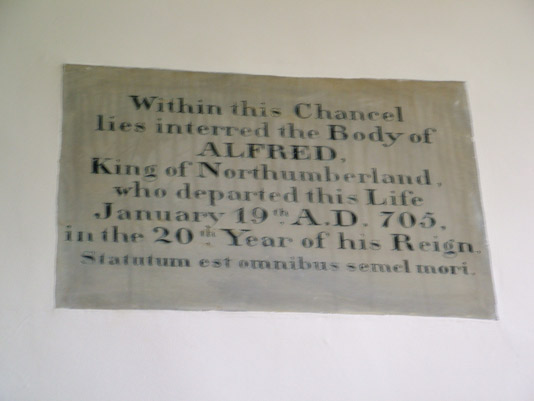
Within this chancel lies interred the body of Alfred King of Northumberland, who departed this life January 19th A.D.705, in the 20th year of his reign. Statutum est omnibus semel mori.
The chief interest of this little country church lies in its associations. Within its walls, 12 centuries ago, a king was wont to kneel, and here also he found his last resting place. On a marble tablet in the chancel is inscribed - "Within this chancel lies interred the body of Alfred, King of Northumberland, who departed this life January 19th, A.D. 705, in the 20th year of his reign."Statutum est omnibus semel mori" (It is appointed unto men once to die). This inscription is modern and has been twice or thrice renewed, but an older one and differently worded is said to have been painted in fresco on the walls of the church taken down in 1807. Several searches have been made for the bones of the king, but neither tomb nor monument has been found. It has, however, been discovered that the spacious chancel of the early church was contracted at a subsequent rebuilding, and, consequently, if the body was interred near the north wall, the grave would be, after the contraction of the chancel, without the walls and in the churchyard.
It is believed, that there was here at the time of this monarch's death a royal palace, where he died after a long illness. But it is also said, that he died of wounds received in battle, at Ebberston, near Scarborough.
That this neighbourhood has at one time been the theatre of extensive military operations, is manifest from the numerous tumuli in the neighbourhood called "The Danes' Graves;" but we search in vain for any well authenticated historical proof that the Saxon monarch fell in battle either here or elsewhere; and William, of Malmesbury states distinctly that he died of a painful disease, which was regarded as a visitation of Providence towards the king, for expelling Saint Wilfrid from his dignity and possessions.
An idle story, published at the instance of people whose rank and education ought to have taught them better, has been propagated, and found its way into many publications, to the effect that in the year 1784, the Society of Antiquarians in London, sent a deputation to this place, to search for the body of the king, (which king they have converted into Alfred the Great, who died 200 years later.) The deputation, it is added, began their labours on the 20th of September and terminated them with complete success; for, after digging some time within the chancel, they found a stone coffin, on opening which the entire skeleton of that prince presented itself, with a great part of his steel armour. The Antiquarians, who searched for the remains of Alfred, consisted of a party of gentlemen, from Driffield, at the head of who was a worthy Baronet.
In reality the investigation terminated in entire disappointment -no stone coffin -no steel armour -in fact, no relic whatever of that monarch was found; and the self appointed delegation, probably to blunt the edge of ridicule to which they might have been exposed, vamped up this fabrication, which a regard for the fidelity of history has induced us to explode, on the authority of the worthy clergyman who at present fills the office of perpetual curate.
In the year 1807, when the church of Little Driffield was taken down and rebuilt, the Rev. Gentleman to whom we have just alluded made another search, but in vain, for the remains of Alfred. When the foundations were bared, it was found that the church and the chancel had both been contracted in size and that if Alfred had really been interred near the North wall, upon which the inscription was formerly painted, that his remains must now be in the church yard.
Of the inscription itself the origin is unknown; but it is known that it has been twice renewed within the memory of man, and that it has undergone various modifications.
( Description © With kind permisson of C. Hinson ).